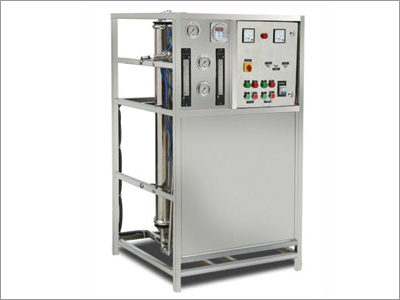Product Description
Reverse Osmosis Plant
The basic concept of Reverse Osmosis Plant is to purify water to its natural form i.e. to preserve the original chemical composition of water in order to produce water fit for industrial & drinking purposes We employ the latest membrane separation techniques for the purpose underlined above Membrane separation techniques or Reverse Osmosis Technology as it is known commonly involves purification of water by migration of water by molecular rejection of dissolved solids. In this pre-treated water is pumped to the membrane at a certain pressure so as to reverse the process c osmosis. As a result of this pressure the pure water migrates from the concentrated portions ti produce perfectly sterilized water.
ADVANTAGES:
• Compact design & less space required • Continuous system operation
• No regeration required • No pollution sustains required
Reverse osmosis is the process of forcing a solvent from a region of high solute concentration through a membrane to a region of low solute concentration by applying a pressure in excess of the osmotic pressure. This is the reverse of the normal osmosis process, which is the natural movement of solvent from an area of low solute concentration, through a membrane, to an area of high solute concentration when no external pressure is applied. The membrane here is semi permeable, meaning it allows the passage of solvent but not of solute. To illustrate, imagine a semi permeable membrane with fresh water on one side and a concentrated aqueous solution on the other side. If normal osmosis takes place, the fresh water will cross the membrane to dilute the concentrated solution. In reverse osmosis, pressure is exerted on the side with the concentrated solution to force the water molecules across the membrane to the fresh water side.
The membranes used for reverse osmosis have a dense polymer barrier layer in which separation takes place. Since Reverse Osmosis does not occur naturally, it must be created by applying pressure to the high solids water in order to force it through the membrane, with pressures from 8 - 14 bars for fresh and brackish water, and 40 - 70 bar for seawater, which has around 24 bar (350 psi) natural osmotic pressure which must be overcome.
Design Considerations
DHIR TECHNOMAN RO Plants work on the Cross flow Filtration method, which takes the feed water and uses a percentage of it as a wash or reject stream, removing the solids during the filtration process.
The product flow of an RO is mainly a function of temperature and pressure. System recovery (product divided by feed) is limited by the characteristics of the feed water and can be controlled through the use of recycle stream. Product quality is based on a percentage of dissolved solids fed to the membrane. There should be an economic balance between product quality and system recovery. High recoveries increase concentration of dissolved solids in the system which degrades quality, but high recoveries make the system work more efficiently and decrease waste.
RO units do not deliver to service all of the water that is fed to them. During operation, some of the incoming water is used to wash down the membrane, and only part becomes finished product water. Purified water is referred to as product and waste water is referred to as concentrate, or reject. The percent of water delivered as product is called the recovery, and depends upon the membrane and on total RO unit design considerations.
Pretreatment
The feed water, depending on its source, may contain various concentrations of suspended solids and dissolved matter. Suspended solids may consist of inorganic particles, colloidal particles and biological impurities such as microorganisms and algae. Dissolved matter may consist of highly soluble salts, such as chlorides, and sparingly soluble salts, such as carbonates, sulfates, and silica.
During the RO process, the volume of feed water decreases, and the concentration of suspended particles and dissolved ions increases. Suspended particles may settle on the membrane surface, thus blocking feed channels and increasing pressure drop across the system. Sparingly soluble salts may precipitate from the concentrate stream, create scale on the membrane surface, and result in lower water permeability through the RO membranes. This process of formation of a deposited layer on a membrane surface is called membrane fouling and results in performance decline of the RO system. The objective of the feed water pretreatment process is to improve the quality of the feed water to the level which would result in reliable operation of the RO membranes. Based on the raw water quality, the pretreatment process may consist of all or some of the following treatment steps:
Clarification followed by Sand Filtration for Turbidity removal
Water disinfection with chlorine
Hardness reduction by Softening
Addition of scale inhibitor
Reduction of free chlorine using sodium bisulfate/ Activated carbon filters
Final removal of suspended particles using cartridge filters
Post Treatment
Based on the Output water quality required, the post treatment process may consist of all or some of the following treatment steps
Ozonation
Ultra-violet
chlorination systems

